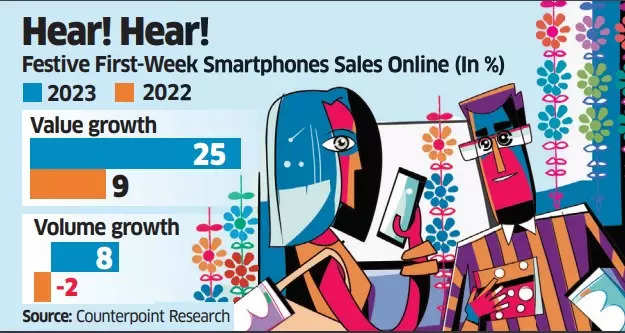[ad_1]

Flipkart is on course to clock around Rs 33,000-36,000 crore in gross merchandise value (GMV) during the ongoing festive season sale which is expected to continue until around Diwali in November lasting 40-45 days, people aware of the matter said.
The Walmart-owned ecommerce major, which has maintained market leadership over rival Amazon India over the past two years, began the second leg of its festive season sale on Sunday after a better-than-expected start to its flagship Big Billion Days sale in early October, they added. Typically, these sales are run in three stages in order to drive a significant chunk of the total annual sales during this period.
“The start of the sale cycle has been positive, which began on October 8 and (Flipkart) should be on track to hit GMV of around $4-$4.5 billion,” said one person aware of the sales trajectory so far. This will mark an increase of up to 15-20% from the GMV recorded by the ecommerce major in 2022.
GMV refers to the total value of the goods being sold on an online marketplace. Flipkart earns a commission on each sale for offering its marketplace, connecting merchants and consumers.
Flipkart also generates revenue through other seller services like advertising.
A spokesperson for Flipkart did not reply to ET’s queries on the sales numbers.
Flipkart and Amazon India — the two largest ecommerce players in the country — have both indicated in press statements that the festive sales have begun on a bright note. The two companies do not share individual gross sale numbers on their platforms.
This year, during the first week of the festive season sales on ecommerce marketplaces, GMV grew by about 18% to around $4 billion, according to Datum Intelligence, a market research firm. It expects the ecommerce industry to reach an overall GMV of around $9 billion by the end of this year’s festive season.
“These (Flipkart GMV numbers) estimates are realistic and in line with market data. Flipkart is still big on smartphones, fashion and appliances — which are key segments, especially during this period,” said Satish Meena, an advisor to Datum Intelligence.
According to people in the know, the growth in Flipkart sales can be attributed to an uptick in demand for high-value items across categories, including high-end smartphones, electronics and appliances. At least two executives from third-party logistics companies confirmed this trend based on details of shipments processed by them.
Data from Counterpoint Research showed that sales of premium smartphones “doubled across online channels” and that 80% of phones sold on Amazon and Flipkart during the first 48 hours of sale were 5G-capable.
“We expect festive season smartphone sales to grow 7% YoY in volumes and 15% YoY in terms of the average selling price (ASP) this year. Smartphones, electronics & appliances and fashion are the top categories for ecommerce marketplaces,” the firm said in a note issued last Friday.
Premium shopping
Industry executives point to a rising trend of “premiumisation” across both online and offline retail that is buoying the sector after muted sales during the first half of the year. “Although, the sluggish growth in sales of low-value items has continued in festive season sales as well,” said one person in the know.
“It is crucial for the marketplaces that new customers come in so that they are not just relying on repeat users. That would be important for the rest of the festive season as well as the full year,” a senior ecommerce industry executive said.
ET had reported in July – citing second-quarter sales volume – that there was a drop in sales volume for products under Rs 500.
According to multiple industry executives, this also indicates how a certain class of users are driving overall sales while the broader consumer base may not be able to contribute as much with pressure on income and overall inflation. In two separate interactions with ET, Amazon India executives have said they are seeing “strong premiumisation across categories”.
“Fashion this year was the most affected segment throughout. Offline stores are also back in the groove now and there is a control in the inventory being released for online as well as on its pricing,” said an industry executive aware of the trends.
Sources added that Flipkart’s newly launched paid subscription programme VIP has also led to more affluent users from top metros spending more on the platform across businesses like Cleartrip for travel bookings. VIP was launched in metro cities like New Delhi, Bengaluru and Mumbai just before the start of Big Billion Days, offering next-day delivery.
Amazon’s signature subscription programme Prime also sees its subscribers typically spend more on the platform across the year than its non-Prime subscribers. Soon after Flipkart VIP’s launch, Amazon also unveiled a service called Prime Shopping Edition, just before the start of its flagship sale event – Great Indian Festival. The new membership has been priced at Rs 399 for one year with limited shopping-related benefits like free shipping and one-day deliveries.
Datum’s Meena added that while repeat users from urban markets are driving the value growth, non-metro markets are playing an important role in overall volume growth. “Platforms like Flipkart, Meesho and Amazon are seeing volume growth from non-metro markets,” he said.
[ad_2]
Source link






